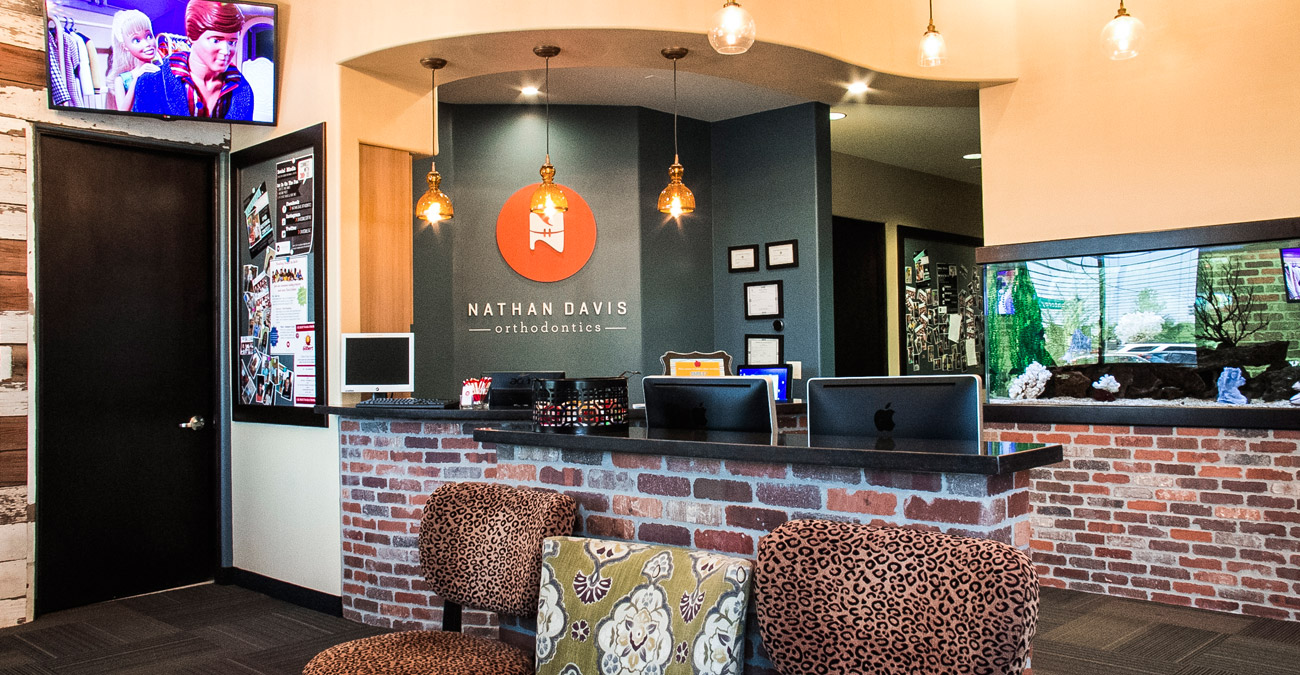What to Expect at Your First Visit
First visits are our favorite! We love having new people visit us at Nathan Davis Orthodontics. In fact, the only thing better than first visits are last visits, when we get to see your brand new smile!
Scheduling your first visit is as simple as giving us a call at 480-969-8500.
During your first visit, you’ll get to meet Dr. Davis and his staff, have a few good laughs, maybe enjoy a slushie and hopefully feel the fun energy we’ve worked hard to fill our office with.
Your initial appointment will consist of a thorough examination and a discussion of potential treatment options. This important 60-minute visit will give us insight into your orthodontic needs, including digital X-rays and photos, which are necessary for developing the appropriate treatment plan.
During the initial examination, Dr. Davis will answer the following questions that cover the basics of orthodontic treatment. We encourage you to ask questions as well.
Is there a condition that orthodontics can address?
Is treatment needed now or should treatment be delayed until appropriate growth, tooth eruption or other factors have occurred?
What treatment procedures will be used to correct the problem?
Do any permanent teeth need to be removed?
How long will treatment take?
How much will it cost?
What are my payment options?
While we can often answer these general questions about treatment during the initial examination, we will address specific areas after careful analysis of the diagnostic records. We feel it is important to analyze each patient’s specific needs, because in-depth planning leads to superior results and higher patient satisfaction.
Please assist us by providing the following information at the time of your first visit:
Any panoramic X-ray taken within the past six months.
If you have orthodontic insurance, bring your insurance card. By providing this information at the first visit, we will be able to give you an estimate of your costs.
Financing/Insurance
It is our mission to provide you with affordable, high-quality treatment that fits your budget! We offer:
Interest-free in-house financing and third-party financing through CareCredit.
Discount for patients who pay in full at the onset of treatment
Visa and MasterCard payment
Insurance
If your insurance covers orthodontic treatment, you will receive the benefit of reduced personal costs. Many insurance policies have a lifetime orthodontic benefit that is distinct from regular dental insurance. Remember that insurance policies vary, and we will review your insurance to determine the appropriate course of action. Once treatment has started, we will file your claims for you.
To help us with your insurance filing, please complete the insurance questions on our Patient Information Form.
Please remember that orthodontic insurance is a benefit for you or your child. If, during the course of treatment, your benefits change, the financially responsible party is accountable for all charges.
Oral Hygiene
Interdental Toothbrush
A Proxabrush is an interdental (between the teeth) toothbrush that you may use to clean underneath and around your wires and braces. Use the Proxabrush gently to avoid damaging your wires. The Proxabrush will help you to clean your braces while maintaining healthy teeth and gums.
Antibacterial Mouthwash
Peroxyl, a hydrogen peroxide antiseptic mouth rinse, will reduce inflammation to your gums and cheeks. Peroxyl helps to prevent infection and decrease irritation that may develop from your braces. Rinse your mouth with two teaspoons of Peroxyl (half a capful) for one minute and then spit it out. You may use Peroxyl up to four times daily following your schedule for brushing: after meals (or after school) and before bed. Just like using peroxide for a scrape on your skin, Peroxyl helps the inside of your mouth heal. Peroxyl can be used for general irritation caused by your braces or for canker sores, cheek bites and other minor temporary injuries to the gums.
Topical Fluoride
Phos-Flur is a sodium fluoride rinse that helps prevent tooth decay while you are wearing braces by killing bacteria and replacing minerals in tooth enamel that have been exposed to harmful acids. The use of Phos-Flur does not replace daily brushing and flossing but should be done following your daily schedule at bedtime. Rinse with Phos-Flur for one minute and spit out. You may not eat or drink for 30 minutes after you use Phos-Flur. It is important for the active ingredient to stay on your teeth for 30 minutes, so do not wash it away by eating or drinking.
Cleaning Your Removable Appliance
Brush your removable appliance every day as a part of your regular brushing and flossing schedule. Because food particles and plaque can accumulate on your appliance just as they do on your teeth, soak the appliance daily. Dissolve a Polident, Efferdent or other denture-cleaning tablet in a glass of tap water at room temperature and soak your appliance once every day. Your appliance will taste better, and you will prevent plaque and bacterial accumulation.
Common Problems
Upper Front Teeth Protrusion
The appearance and function of your teeth are impacted by this type of bite. It is characterized by the upper teeth extending too far forward or the lower teeth not extending far enough forward.
Overbite
The upper front teeth extend out over the lower front teeth, sometimes causing the lower front teeth to bite into the roof of the mouth.
Crossbite
The upper teeth sit inside the lower teeth, which may cause tooth stratification and misaligned jaw growth.
Openbite
Proper chewing is impacted by this type of bite, in which the upper and lower front teeth do not overlap. Openbite may cause a number of unwanted habits, such as tongue thrusting.
Other Problems
Crowding
Crowding occurs when teeth have insufficient room to erupt from the gum. Crowding can often be corrected by expansion, and many times, tooth removal can be avoided.
Spacing
Spacing problems may be caused by missing teeth, or they may only be a cosmetic or aesthetic issue.
Dental Midlines Not Matched
This type of problem may be caused when the back bite does not fit and match appropriately. This may negatively impact jaw and proper dental function. It might also be caused by anterior crowding of teeth.
Emergency
What to Do in Case of Emergency
Call our office as soon as possible if you break or loosen any of your appliances. Please do not come directly to the office – by calling us, you will allow us to create a time to see you. Even if you have a regular appointment scheduled, call us immediately to notify us if you need an appliance repaired.
Loose Brackets or Bands
Call our office immediately for advice if a bracket or wire is loosened. The bracket may need to be re-fitted as soon as possible. You may have a situation that requires cutting a wire or sliding a bracket off a wire at night or over the weekend. If you need to cut a wire in case of emergency, you may use fingernail clippers that have been washed and sterilized in alcohol. Please call our office the next business day, so that we may schedule an appointment for you.
Wire Irritations
Sometimes discomfort caused by a wire on your braces can be resolved by moving the wire away from the irritated area with a cotton swab or eraser. If the wire will not move, try covering the end of it with a small piece of cotton or a small amount of wax. If the wire is painful, you can cut it with nail clippers or scissors that have been washed and sterilized in alcohol. If you cannot resolve the wire irritation, call our office for an appointment.
Lost Separators
Most patients lose a separator during their treatment. Do not worry about losing a separator, but call our office to see if it needs to be replaced.
Discomfort with Orthodontic Treatment
During the first week after your braces are in place and routine adjustments are complete, you will likely feel some pain, soreness or discomfort. You may take acetaminophen or other non-aspirin pain relievers while you adjust to your new braces. A warm wash cloth or heating pad may reduce the soreness in your jaws.

